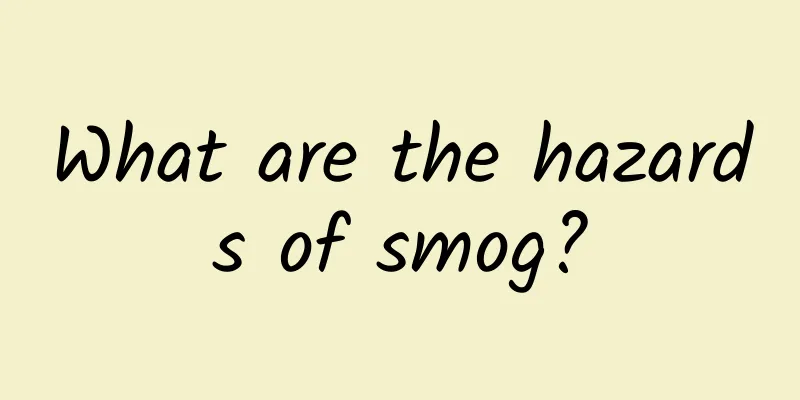What are the hazards of smog?

|
As the times develop and technology advances, our environment has been damaged to varying degrees. Especially in recent years, smog weather has become more and more frequent. The causes of smog weather are automobile exhaust, chemical fuels, etc. Sulfur dioxide, nitrogen oxides and inhalable particulate matter are the main components of smog, which is harmful to the human body. Many areas have regarded smog days as catastrophic climate. Fog is colorless water vapor, but if a large number of extremely fine dry dust particles float evenly in the air, making the horizontal visibility less than 10 kilometers and the air generally turbid, haze is formed. PM2.5 is the main cause of haze weather. The color of fog is milky white and bluish white, while that of haze is yellow and orange-gray; the boundary of fog is very clear, but the boundary between haze and the surrounding environment is not obvious. Due to the small size of PM2.5 particles, they can absorb toxic and harmful chemicals and microorganisms such as bacteria and viruses, and enter the human respiratory tract with breathing, irritating sensitive parts of the nose, bronchial mucosa and other parts of the body, or be directly inhaled into the lungs, causing diseases including asthma, bronchitis and cardiovascular disease. Another hazard of PM2.5 is that it is an important carrier of pathogenic microorganisms (such as SARS, H1N1, Legionella, etc.), which will fuel the spread of diseases. Haze particles are harmful to the human body The health effects of particulate matter of different sizes are related to the time they stay in the atmosphere, where they remain in the respiratory tract, and the harmful substances they absorb. Particles with small size are more stable in the atmosphere and settle more slowly. Generally, it takes 9 hours for particles of 10 microns to settle to the ground, while particles of 1 micron take 9 to 98 days, particles of 0.4 microns take 120 to 140 days, and particles smaller than 0.1 microns take 5 to 10 years. The longer particulate matter stays in the atmosphere, the greater the chance of being inhaled into the human body. Inhalable particles of different sizes are retained in different parts of the respiratory tract. Those larger than 5 microns are mostly retained in the upper respiratory tract, that is, deposited in the nasopharynx, trachea and bronchus areas. These particles do not stay for long and are eliminated through ciliary movement, swallowing, coughing or sneezing. Particles smaller than 5 microns are mostly retained in the bronchioles and alveoli. The smaller the particles, the deeper they penetrate. Particles smaller than 1 micron have a high deposition rate in the alveoli, but particles smaller than 0.4 microns can enter and exit the alveoli more freely and be exhaled from the body. Foreign studies have found that 60% to 90% of harmful substances exist in particles smaller than 10 microns. These small particles are easily deposited in the alveolar area, and the absorption rate of lead in the alveoli can reach 70%. Particles reduce human immunity Particulate matter itself contains a variety of harmful substances and is also a carrier of pollutants, so it poses many hazards to the human body. First, particulate matter can irritate and corrode the alveolar wall. Long-term effects can destroy the defense function of the respiratory tract, leading to diseases such as chronic bronchitis, emphysema, and bronchial asthma. Secondly, particulate matter can cause a decline in human immune function. Studies have found that the immune function of primary school students who are exposed to particulate matter pollution for a long time will be significantly suppressed. On the other hand, particulate matter can also increase an animal's susceptibility to bacteria, leading to a decrease in the lungs' resistance to infection. For example, residents who have lived in areas with severe particulate matter pollution for a long time have an increased prevalence of respiratory diseases and symptoms such as coughing, sputum, and shortness of breath. The smaller the particle size, the more toxic it is to the lungs. Thirdly, particulate matter can absorb and scatter solar radiation, thereby reducing the intensity of ultraviolet rays at the ground, which have bactericidal and anti-rickets effects. Therefore, in areas with severe particulate matter pollution, the incidence of rickets in children increases and the incidence of airborne infectious diseases (such as tonsillitis) increases. Finally, particles that land on the skin or in the eyes can cause blockage of the sebaceous glands and sweat glands, leading to diseases such as dermatitis and conjunctivitis. The above introduces the harm caused by smog to the human body. We remind you to stay at home less on smoggy days. If you go out, it is best to wear a smog-proof mask. Some middle-aged and elderly people and children should pay more attention to protecting their bodies on smoggy days. In our daily lives, we must also start with ourselves to improve the environment on which we depend for survival. |
<<: What are the common Chinese herbal medicines?
>>: The efficacy and function of Chinese herbal medicine Jiaogulan
Recommend
I really can't take medicine anymore if I have stomach discomfort.
Poor gastrointestinal function is a common proble...
What to do if a pregnant woman has bladder leakage
Bladder leakage is quite common in the late stage...
Why does my eardrum hurt?
Although the ear is a relatively small organ, it ...
Newborn baby dancing and fussing
We all know that newborn babies are very quiet an...
Can I eat mango after cesarean section?
For many pregnant women, giving birth is a very d...
What is whooping cough
Whooping cough may be mainly some acute respirato...
Ways to control blood sugar
Stable blood sugar is a common aspect that diabet...
How to relieve stomach pain but can't defecate?
In real life, many people have irregular diets wh...
What to do if a low-grade fever persists
As the development of modernization is constantly...
What medicine to use for vulvar itching
Vulvar itching is one of the most common symptoms...
What to do if your nose is burning?
People with a hot nose should be careful not to p...
What foods can’t babies eat when they have diarrhea?
Babies who are in the developmental stage have re...
Gastroenteritis affects the waist
Gastroenteritis is a very common gastrointestinal...
I have stomach pain all the time and my period has not come. What's going on?
Most women have experienced delayed menstruation....
Is ceftriaxone useful for rhinitis?
Rhinitis is a common disease in life, especially ...









